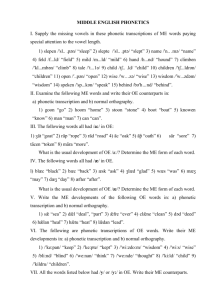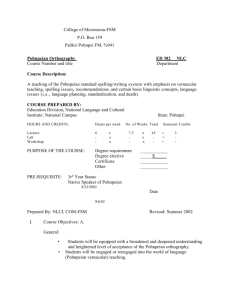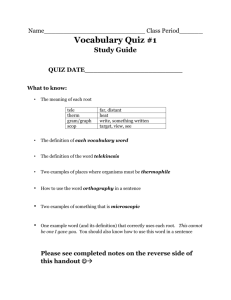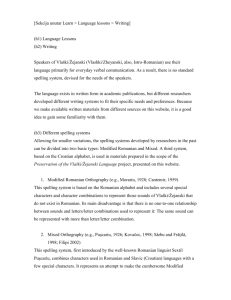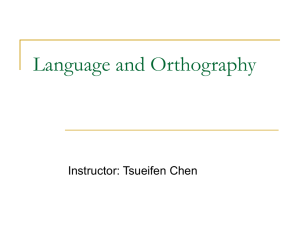1. What is an orthography?
advertisement
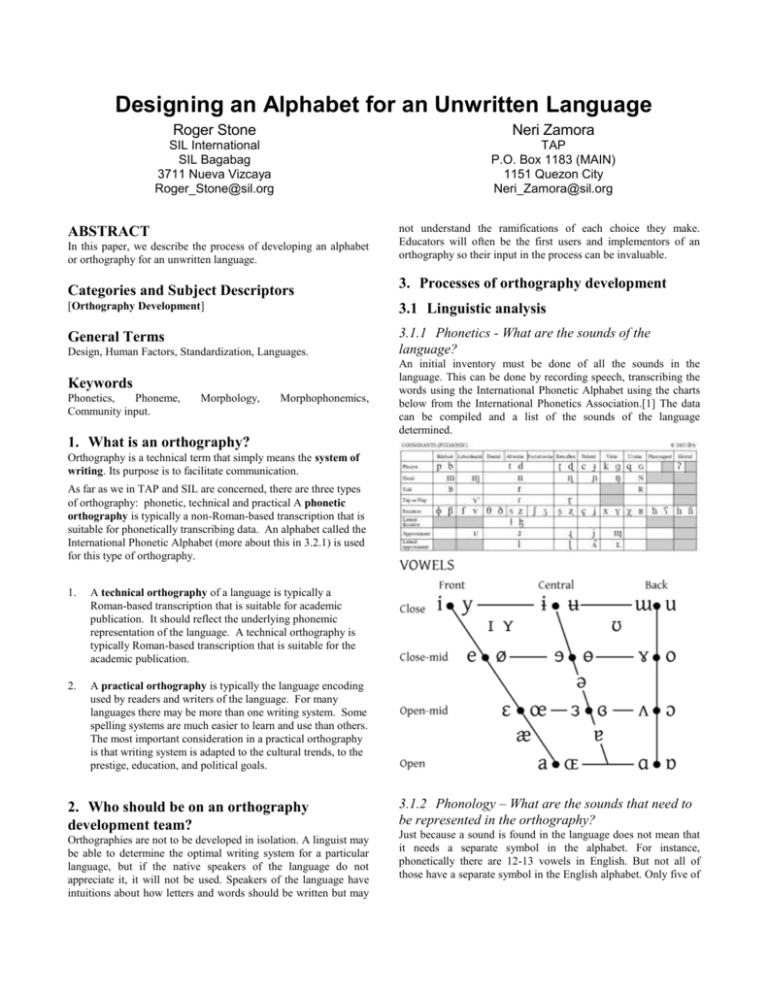
Designing an Alphabet for an Unwritten Language
Roger Stone
Neri Zamora
SIL International
SIL Bagabag
3711 Nueva Vizcaya
Roger_Stone@sil.org
TAP
P.O. Box 1183 (MAIN)
1151 Quezon City
Neri_Zamora@sil.org
ABSTRACT
In this paper, we describe the process of developing an alphabet
or orthography for an unwritten language.
Categories and Subject Descriptors
not understand the ramifications of each choice they make.
Educators will often be the first users and implementors of an
orthography so their input in the process can be invaluable.
3. Processes of orthography development
[Orthography Development]
3.1 Linguistic analysis
General Terms
3.1.1 Phonetics - What are the sounds of the
language?
Design, Human Factors, Standardization, Languages.
Keywords
Phonetics,
Phoneme,
Community input.
Morphology,
Morphophonemics,
An initial inventory must be done of all the sounds in the
language. This can be done by recording speech, transcribing the
words using the International Phonetic Alphabet using the charts
below from the International Phonetics Association.[1] The data
can be compiled and a list of the sounds of the language
determined.
1. What is an orthography?
Orthography is a technical term that simply means the system of
writing. Its purpose is to facilitate communication.
As far as we in TAP and SIL are concerned, there are three types
of orthography: phonetic, technical and practical A phonetic
orthography is typically a non-Roman-based transcription that is
suitable for phonetically transcribing data. An alphabet called the
International Phonetic Alphabet (more about this in 3.2.1) is used
for this type of orthography.
1.
A technical orthography of a language is typically a
Roman-based transcription that is suitable for academic
publication. It should reflect the underlying phonemic
representation of the language. A technical orthography is
typically Roman-based transcription that is suitable for the
academic publication.
2.
A practical orthography is typically the language encoding
used by readers and writers of the language. For many
languages there may be more than one writing system. Some
spelling systems are much easier to learn and use than others.
The most important consideration in a practical orthography
is that writing system is adapted to the cultural trends, to the
prestige, education, and political goals.
2. Who should be on an orthography
development team?
Orthographies are not to be developed in isolation. A linguist may
be able to determine the optimal writing system for a particular
language, but if the native speakers of the language do not
appreciate it, it will not be used. Speakers of the language have
intuitions about how letters and words should be written but may
3.1.2 Phonology – What are the sounds that need to
be represented in the orthography?
Just because a sound is found in the language does not mean that
it needs a separate symbol in the alphabet. For instance,
phonetically there are 12-13 vowels in English. But not all of
those have a separate symbol in the English alphabet. Only five of
those sounds are represented in the alphabet because there are
only five “phonemes”.
The e in the English word roses is a good example. The phonetic
sound is ɨ but the symbol e is used. The sound that actually comes
out of people’s mouths is different than the prototypical e sound.
Why does this happen? Sounds are influenced by the sounds
around them. The presence of two s or z sounds (both symbolized
by “s”) causes the e sound to become phonetic ɨ. This is
predictable in light of the s or z sound being made by when the
tongue is placed in the middle of the mouth. The e sound also is
made in the front of the mouth whereas the ɨ sound is made in the
middle of the mouth. So, the e sound assimilates to the place of
articulation of the consonants around it.
In Ayta Abellen there are four vowel phonemes although if one
listens to speakers of the language and carefully transcribes the
uses of the vowel o, one will hear that sometimes the speakers are
actually saying u. To date the orthography has only been using
one symbol o for these two sounds and we have yet to discover a
word where not writing two symbols has affected reading ability.
So, if sounds are being influenced by the sounds around them,
how do we know when to use two symbols or just one? In
phonology there is a term called “minimal pair”, where two words
have all the same sounds except one. When this happens we can
say that the difference between those two sounds is significant and
most likely the distinction will need to be represented in the
orthography. An example in Tagalog is kulay and gulay. Even
though k and g are phonetically similar (both made by placing the
tongue at the back of the mouth) there have to be separate k and g
symbols in the Tagalog orthography so that the differences in
meaning can be determined by the reader.
consistently. In the case of the example above, the third sample is
the most common way of writing this in Ilokano with the pronoun
attaching to the verb and the two particles being written as
separate words.
3.1.4 Morphophonemics – What to do when affixes
collide?
Morphophonemics is “the study of phonemic variations in
morphemes”. When a prefix is added onto a root there may be
changes in the sounds made either at the end of the prefix or the
beginning of the root. A simple example is darating in Tagalog.
We know that the root is dating and the prefix is da-. The sound
that is actually pronounced, though, is r and so the Tagalog
orthography calls for writing this phonetically rather than
phonemically. Phonemically this would be dadating.
Language communities might not always want to choose the
phonetic spelling as they may want to retain the original phoneme.
For example the Ayta MagIndi have a prefix in-. When it attaches
to a root that begins with p or b the natural tendency is to say im-.
When occuring before roots beginning with t or d the natural
tendency is to say in- and when before k or g the tendency is ing-.
At present the Ayta MagIndi writers are trying to decide whether
it is best to write all of these cases as in- or to alternate between
im-, in-, and ing- depending on the following letter.
3.2 Community Input
“Orthography development is a participatory process. It should
be designed, implemented, and managed by the language
community. During the process, participants must make many
decisions related to factors that affect orthography development.
Stress can also be phonemic but is often not written as in the case
of ta’yo ‘to stand’ and ‘tayo ‘we’. In cases like this the context
may be used by the reader to determine which form is being
referenced.
As participants become more and more aware of the structures of
the language, they will need to make orthography revisions.
During the process of testing and revising, a developing
orthography is classified according to the type of revisions it has
undergone.”[2]
3.1.3 Morphology – Where do the words and affixes
begin and end?
There are often three stages in the process. Stage one is a trial or
“initial” orthography. Stage two is an approved or “working”
orthography. Stage three is an established or
“standard”
orthography.
Morphology is the identification, analysis and description of the
structure of words. This includes the identification of the
boundaries between prefixes, suffixes, and infixes in relation to
the root. It also includes the identification of the boundaries of
words.
4. Questions to consider
“Is it easy to teach?
For unwritten languages it is important that there is adequate
analysis of where words begin and end. For instance, many
northern Philippine languages like Ilokano have pronouns and
particles that always follow the verb and when people speak it can
sound like those words are attached. For instance, the phrase “I
also would like to stand” could be written any of several ways.
Is it easy to read?
Is it easy to write?
Can it be typed?
Will words be too long?
Will bridging to Tagalog be difficult?
Tumakder ak koma metten.
Do people like it”[3]
Tumakderakkomametten.
Tumakderak koma metten.
Tumakderak komametten.
It is important that the word divisions and their parts of speech be
understood so that if there is a desire to attach some of the parts of
the speech to the verb, a principled writing system can be
specified where words and sentences can be constructed
5. Potential problem areas for Philippine
languages
Use of “o and u”
Symbolization of the offglides (e.g. sya, bwaya)
Symbolizing the glottal
Representation of the juncture of “n” and “g” when they do
not form “ng”
Readability of reduplication (use of hyphen)
Hyphenation
Vowels that are dropped from words during affixation (also
fast speech although it is normally written in the full form)
Contractions
Consonant gemination
Pronoun attachment
Compound words
6. Orthography development samples
6.1 Bolinao
Four areas that we considered when we formed the Bolinao
orthography:
The linguistic evidence (phonemics).
Graphic considerations (writing
instruments available).
Pedagogy (its teachability).
The social acceptance (cultural
considerations).
systems
and
and
political
6.1.1 The Linguistic Evidence (phonemics)
The ideal for a writing system based on sounds is that one and
only one symbol would represent each “emic” sound. (Emic
sounds are the sounds that would change the meaning of a word).
In Bolinao orthography, the letters being used for the nonborrowed words except proper names are: a, b, d, e, g, i, k, l, m, n,
ng, o, p, r, s, t, w, y, and ‘. In borrowed words or loan words all of
the letters of the Romanized alphabet are used following first of
all the spelling in Filipino and, if that is not applicable, then the
foreign spelling.
Letters for which the symbols are consistently used in Bolinao,
Tagalog and Ilocano (the lingua franca) languages are:
a, b, d, g, l, m, n, ng, p, r, s, t
6.1.2 Graphic considerations (Writing systems and
instruments available)
If possible the symbols should be readily reproducible by local
means.
1.
2.
3.
Ideally, the symbols chosen should be available on the
standard typewriter and computer keyboards, printing
presses, or typesetters.
The symbol should be legible even with diacritics.
The symbol should be easily written in cursive script.
Symbols that could be embarrassing to a people group because of
their strangeness should not be used. We did not use, for
instance, η for ng? or for a? or ʃ for sya? or j for y?
6.1.3 Pedagogy (its teachability)
One test of a good orthography is that the speaker of the language
be able to learn to read and write it. Or to put it another way, the
written language should be readily teachable. This makes
consistency a very important factor in developing an orthography.
It also means we need to keep relearning to a minimum. Thus
what is already being taught by local school and for the
national language is a heavy factor to consider. Having learned
to read the national language or the trade language of the area, a
reader should be able to read in his native language with as little
difficulty as possible as the transference of the value of the
symbols. But, Smalley (1963:23) has summarized an alternative
viewpoint as follows: It is not what is easiest to learn, but what
people want to learn and use which ultimately determines
orthographies.” We need to be open and very flexible in our
attitudes as we seek to formulate orthographies.
Part I of the orthography testing done in 1980 was a spelling test
consisting of 65 words given orally in order to give opportunity
for individuals to write words as they thought they should be
written.
Part II was a multiple choice test that gave opportunity to choose
from various options. The results of Part I and Part II were
consistent with each other and confirmed the present orthographic
choices. Amongst the older people there was some use of C and
QU instead of K but even there some consistently used K. The
younger people used the K. The younger people tended to use the
hyphen for the glottal sound in the position following a consonant
as in Tagalog but otherwise consistently used a symbol similar to
the apostrophe preceding a consonant. Final glottals were
generally marked. The symbols used in the pre-consonant and
final positions were first the apostrophe ('), second the grave
accent (`) third the circumflex (^). The use of offglides, Y and W,
depended on if the word used was cognate in Tagalog or Ilocano.
The corresponding shape was used. All permutations were used.
Generally the O-U rule of the last syllable using O, and U being
used elsewhere was followed except by the older people who
retained the shape of the root when affixing or reduplicating. The
separation of particles following the verb and pronouns was based
on the formation of the stress groups which normally meant the
pronouns were separated from the verb and grouped into separate
words containing more than one morpheme. These pronoun
“words” may or may not contain some of the particles.
Part III of the test was to demonstrate readability. Part A
involved reading individual words out of context and Part B
involved reading a story given by a Bolinao speaker. The reading
test gave results consistent with the demonstrated reading ability
of the person in other areas and so confirmed the orthographic
choices.
6.1.4 The social acceptance (cultural and political
considerations)
What the people will use is the ultimate force. Of course we can
anticipate this to some extent and also train people in the
“official” way but after that, it will come back to what is being
accepted and used.
A primary factor here is the major language. In your case,
Tagalog or Filipino has the primary influence since that is what is
taught in schools, heard on TV and offers advancement within the
country. This will influence the choice of symbols, word breaks,
glides and other choices.
Also, history affects the cultural pressure and so we have
conflicts in Bolinao between Spanish spellings and national
language spelling. The Spanish Romanized the ancient Baybayin
form of writing. They, however, had no “K” in their alphabet and
so used ”C” and “QU”. They also had difficulty in representing
the “NG” sound and used several ways to try to represent this as
one sound. The “W” sound was also absent in their Romanization
and so they used diphthongs instead (au, iu, ou, oe, ua, ui, and
uo). Rizal tried to harmonize these points in Tagalog when he
simplified the Spanish “C” “CQ” and “QU” to “K” and the
problem of diphtongs by the use of “W” and “Y”.
The preferences of people is also considered. You may have
varying opinions on the marking of the glottal. In Bolinao, it is
generally the older people that want to retain “C” and “QU”.
Pressures that may be placed by the government (approval of
KWF) on languages may also be a factor.
6.2 Ayta languages
The orthographies of the Ayta languages are not as developed. An
orthography was developed for the Ayta MagAntsi language in
conjunction with the publication of the Ayta Mag-antsi-English
dictionary and the Ayta Mag-antsi New Testament but the other
Ayta orthographies are still in process.
The other Ayta languages have initial orthographies that are being
used for test publications. The process being utilized here is what
I call background analysis. As mother tongue speakers draft
translated and original materials the linguist is watching for
patterns and informing the writers about the implications of the
emerging patterns. For example, if a writing pattern is noted that
seems to capture better what is really happening in the language, I
present the pattern to the writers and ask if they would all like to
make that change. If yes, then the writers adjust their future drafts
and I use regularized expression search and replace capabilities in
software to change existing documents. I also inform the writers
of patterns that are not in conformity with the overall orthography.
In this way the writing system is improved over time as the
different choices are discussed in context. It’s kind of like
ongoing analysis is being done in the background.
7. Suggested Practical Procedure
Assess the language and cultural situation
Help community produce some sample materials
Test the materials with readers
Revise orthography as needed
Prepare more sample materials
Present findings to community and seek consensus
through a “Language Congress”
Revise orthography in response to community input
Submit to LGU and/or Komisyon sa Wikang Filipino
8. Computational Tools Available
8.1 Speech Analyzer for Phonetic analysis
Speech Analyzer is for recording speech and analyzing the
resulting wave files. The tool can be useful for determining
syllable length, stress, and even the correct phonetic symbol for
individual sounds. It is downloadable at:
http://www.sil.org/computing/sa/sa_download.htm
8.2 Phonology Assistant for analyzing the
sound system
Phonology Assistant takes phonetic data and helps the analyst
find the patterns in the sound system of the language. It is
downloadable at:
http://www.sil.org/computing/pa/
8.3 FLEx/WeSay for dictionary storage
FLEx is a powerful tool for dictionary development and language
analysis. The tool is designed specifically for these tasks and can
handle virtually any writing system (definitely all in the
Philippines). There is a learning curve to using it but it is free and
very powerful for lexicography and analysis. It is downloadable
at:
http://www.sil.org/computing/fieldworks/flex/
A much less powerful but much easier to use solution for enabling
native speakers of languages to document their words (and the
meanings) is called WeSay. It can run on any Windows or Linux
computer and is also freely downloadable. Teaching someone how
to use it who is not familiar with computers is very simple. It is
downloadable at:
http://www.wesay.org/wiki/Downloads
9. ACKNOWLEDGMENTS
Our thanks to SIL and TAP.
10. REFERENCES
[1] SIL International Literacy Department. 1996. “Develop an
Orthography”. SIL LinguaLinks Library.
[2] http://www.langsci.ucl.ac.uk/ipa/ipachart.html
[3] Easton, Catherine and Diane Wroge. 2002. Manual for
Alphabet Design through Community Interaction for Papua
New Guinea Elementary Teacher Trainers. SIL Papua New
Guinea.

